Aktimate Micro
It’s a funny thing, being an audiophile. We are constantly chasing elusive goals incomprehensible to our (non-audiophile) friends: every possible improvement must be explored; every upgrade path considered; every tweak given due consideration. And then, at some point, we realize that the “system” has gotten much more complicated than we had ever anticipated. So we might simplify, or build a second system, perhaps with a unique goal or characteristic: single-driver, all-tube, or vintage, for example.
I am sure we must have all thought to ourselves at some time, “if only there were a simple solution!” Some of the components reviewed in recent issues of HifiZine, like the Perreaux Audient 80i and the Grant Fidelity W-30GT, are a step in that direction. But what about putting everything into an integrated unit – including the speakers? There are a number of speakers on the market now, ranging in price from budget to very expensive (Meridian), that fit this class of component – the ultimate integrated.
An Australian company, Epoz, recently came out with a new speaker of this type, the Aktimate Micro, that includes a USB connection intended for computer playback. Contained within two boxes (left and right speakers) is all you need for a complete hifi system. Well, and a computer as source… but we all have one of those already, right? The Micro has a price tag to match its diminutive size – $385 RRP here in Australia, with “street” prices even lower. In a world where you can readily pay more than that just for a USB cable, this is an intriguing proposition. So I contacted Epoz about obtaining a review sample… and shortly thereafter took delivery of a fire-engine red pair of Aktimate Micros.
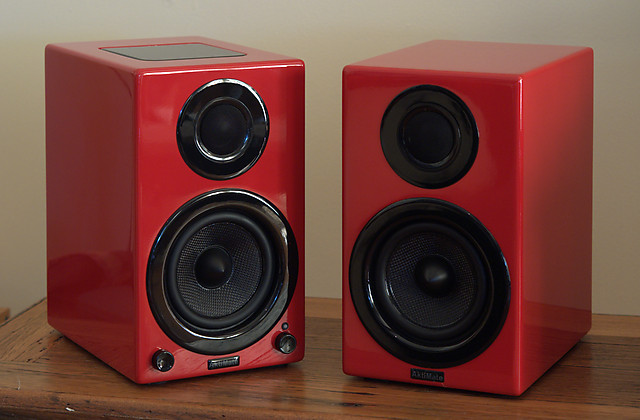
What it is
The Aktimate Micro is a small pair of speakers with amplification and electronics built into one of the speaker cabinets. This is referred to as the “active” speaker, and the other as the “passive” speaker. This terminology may be different from what you are used to, as another common usage has that “active” speakers use an active crossover and separate amplifiers for each driver, and “passive” speakers use a passive crossover between drivers with a single amplifier channel driving the crossover and thus all speaker drivers. The Aktimate is both: a “passive” speaker in that it uses passive components to implement the crossover between the woofer and tweeter, and an “active” speaker in the sense that it includes amplification and other electronics within one of the speaker cabinets.
Each speaker cabinet is 145 x 200 x 240 (WxDxH) mm in size, or about 6.75 x 8 x 9.5 inches. The “active” (left) speaker is noticeably heavier than the “passive” (right) speaker. The cabinets are very nicely finished in a gloss paint. My review pair came in red, which is their most popular colour (according to Jason Pugh of Epoz). They are also available in white and black.
The woofer looks at first to have a phase plug, as in more expensive drivers from e.g. Seas. Closer inspection shows that this is merely the cone shaped to look like a phase plug. No matter. The tweeter is covered with a mesh grill, which will be good news for those with young curious fingers in the house. Each speaker driver is recessed into the front panel, and finished with a plastic bezel to hide the fixing screws.
The active speaker has an iGadget (iPod touch or iPhone) dock hidden beneath a flap in its top. The manual says that you should use the supporting plastic insert that came with your iGadget. Hm… I was not able to find one for my iPhone 3Gs, but did note that they can be purchased from the Apple Store for a few dollars (in lots of three). The dock works fine without the insert, but since the Micro does not have a remote control for the iPod you will need to press on the iGadget to select and play tracks – so it’s probably best to get an insert if you plan to use the dock much.
The rear panel of the active speaker has the plug for the AC power cord, fuse, and power switch near the bottom, and the USB input and 3.5 mm line input jack near the top. A pair of small binding posts are used to connect a speaker cable (supplied) to the “passive” speaker. These are too small for regular “audiophile” spade lugs, so you may as well just use the supplied cable and banana plugs. The rear of the passive speaker has only a recessed pair of binding posts for the cable from the active speaker. Again, it will take spade lugs but they are quite small, so bananas are the order of the day here.
The rear of both speakers has a tapered “slot” bass reflex port at the bottom of the cabinet. This is quite an interesting design, that I will mention again later. Because of the rear port, the speakers will not be able to be placed right back against the wall – and the need to connect cables at the back will prevent this anyway. In terms of physical placement, at least 50-60 mm behind each cabinet will be needed.
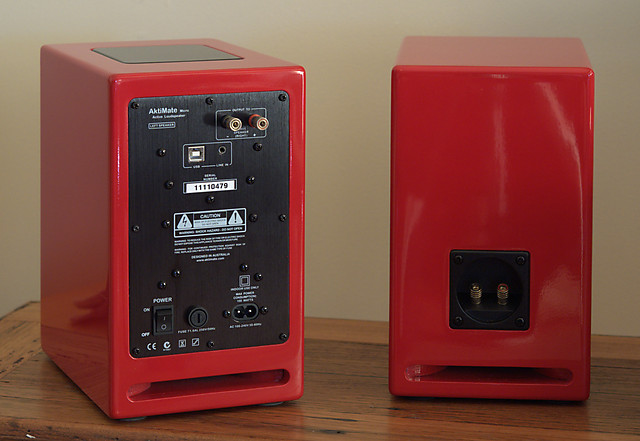
Background
The earlier Aktimate Mini model has been quite successful and garnered many positive reviews. I asked Epoz about the design of the Micro. From Jacki Pugh at Epoz:
Epoz in Australia has its own European engineering team based in China and they work directly with the engineers at the manufacturing company. The woofer was designed exclusively for the Micro to our specification and the tweeter is similar to the one used in the new Epos Epic speakers although not the same. We worked directly with the company who produce the Epos tweeter to provide the one we use in the Micro. The digital amplifier was designed with the factory’s chief engineer and our own engineer working together. All final testing and ‘tweaking’ prior to production was done exclusively by our own engineer.
Jacki told me that the speaker is aimed specifically at the desktop market, hence the USB connector for audio playback. (Earlier models use the USB connector only for charging a docked iPod.) Epoz saw a lack of quality speakers in this area, and their efforts in producing the Micro were rewarded with a “2012 Desktop Audio Product of the Year” award from Sound and Image magazine. Its larger siblings are aimed at slightly different markets, with the Mini aimed at starter hifi systems, and the Maxi for those who desire wireless streaming directly from a computer to the speaker.
Initial measurements
An initial measurement of the Micro in the middle of my living room, with the microphone 50cm from the tweeter, is shown in Figure 1. The on-axis response of the left (“active”) and right (“passive”) speaker is shown in the top pair of curves. There is a significant rise in the treble region, which suggests that the Micro is likely to perform better in rooms with significant damping – carpet, curtains, soft furniture – than more reflective rooms. It is, however, extended and commendably smooth, apart from the overall rise. The two speakers are closely matched, suggesting that imaging will be good. They differ a little in the 2-3 kHz region, but not sufficiently to cause any worry.
The lower set of curves in Figure 1 shows the frequency response on-axis and at 30 and 60 degrees off-axis horizontally. As would be expected, the treble falls off-axis, with it being almost flat at 30 degrees off axis, albeit with a noticeable dip around 2 kHz.
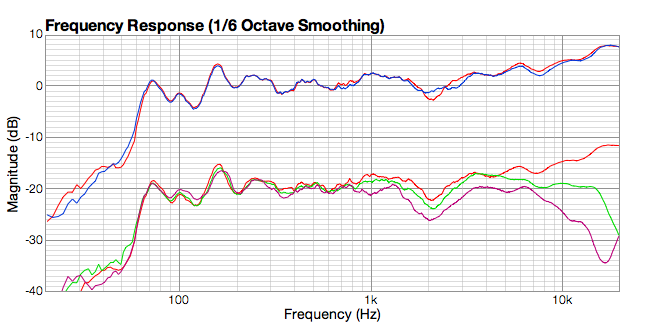
Figure 1. Aktimate micro in-room measurement at 50cm distance. Top curves: on-axis active (red) and passive (blue). Bottom curves: On-axis (red), 30 degrees horizontal (green), 60 degrees horizontal (mauve)
The curves also show that the bass response is tuned to be flat to the roll-off point of around 60 Hz, below which response falls quickly. If listening to music with substantial low-frequency energy, you can expect to miss it with this speaker. (It is only a 4″ woofer after all.) Placing the speakers closer to the wall is likely to be helpful to provide a bit of lift in the bass. Note that the ripples in the bass response are room effects and are not due to the speaker itself. This is confirmed by the nearfield measurement of the woofer and port in Figure 2, which also confirms that the port is tuned to just above 60 Hz.
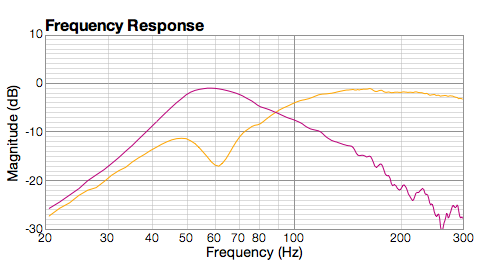
Figure 2. Aktimate Micro nearfield (2.5 cm) measurement of woofer (orange) and port (mauve)
Desktop setup
I let the Micros run in for several weeks in my living room in a small HT / CD system, after which I placed them on my desk and connected the USB input to my iMac (late 2009 model running OS X 10.6 Snow Leopard). The iMac showed that the Micro advertises itself as capable of 44.1 or 48 kHz playback, at 16-bit resolution – that is, standard CD resolution.
I had decided by this time to use the desktop as the main location for evaluation, since that is the intended purpose of the Micro. My desk is 1.4 m wide and 70 cm deep, made of glass, and together with nearby walls, bookshelves, and a large screen, creates a fairly “acoustically hostile” environment. Nonetheless, it’s the desk I have, and I think it’s reasonable to accept some compromises in exchange for the enjoyment of listening to music while chained to it! One thing I did do was place about a cm of felt underneath the speakers, which helped damp vibrations in the glass top of the desk.
I experimented with two placements. In the first, shown at left in Figure 3, the speakers are pointed straight ahead and the speakers and the nominal listening position are positioned in an equilateral triangle. In the second configuration, on the right of Figure 3, the speakers are toed in so that they intersected a small distance in front of me. In both cases, the tweeters are a meter apart, and a meter from the nominal listening position. Note also that my ear level is higher than the tweeter, at 120 cm for my ear and 90 cm for the tweeter.
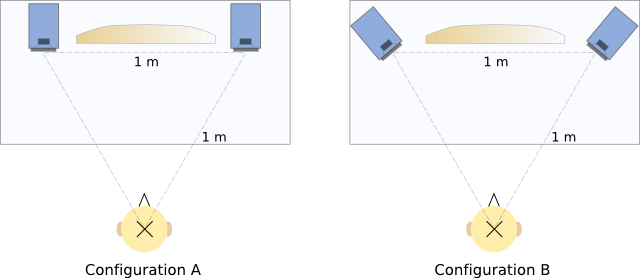
Figure 3. Desktop configurations for Aktimate Micro
To get a handle on the behavior of the speaker when placed in a desktop environment, I ran a number of measurements, some of which are shown below in Figure 4. At the top is Configuration A, with the speakers pointed directly ahead and the listener thus roughly 30 degrees off-axis to each speaker. (As before, red is the active/left speaker and blue is the passive/right speaker.) The off-axis dip around 2 kHz is apparent. The placement close to the wall has elevated the midrange (below 1 kHz) a bit but the lower bass hasn’t seen much of a boost – in my study, that is, yours may be completely different. While the measured bass response is a little light, it is still only 10 dB down (relative to 1 kHz) at 40 Hz.
The middle set of curves show the measured response with the speakers toed in, in Configuration B. The high treble is significantly elevated in comparison to Configuration A. I found it to be a bit too “hot,” although some may like the “airy” sound this gives on some music. The bottom curves show the response in Configuration B with equalization applied – this will be discussed later.
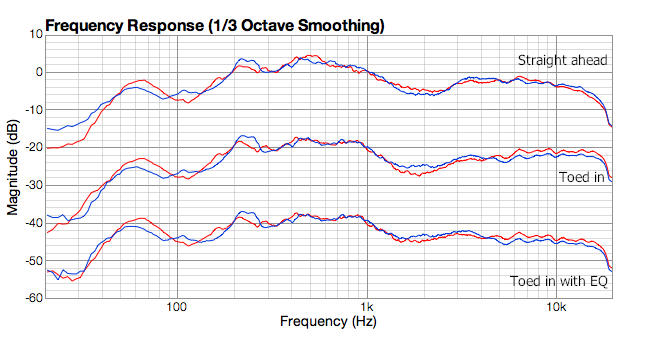
Figure 4. On-desk response curves of Aktimate Micro. Top: speakers pointed ahead; middle: speakers toed in; bottom: speakers toed in and EQ applied. Red is left and blue is right.
Listening impressions
Going into this review, I had to think a bit about how to approach it. I didn’t want the review to merely say “well it’s good for the money.” It’s hard (for me anyway) to find much meaning in a statement like that. On the other hand, it’s inevitable that a component/system that costs a tiny fraction of a full-sized system will have compromises. We can’t realistically expect the same level of resolution, transparency, or dynamics; so the question then becomes: does it deliver an enjoyable listening experience nonetheless?
In a nutshell, it does indeed. In the context familiar to most HifiZine readers, in which each individual component costs several to ten or more times as much as the Micro, the following comments could be considered nit-picking. That is not my intent, but simply to describe accurately the sound of the Micro. I will reference the following tracks, which ran across my screen while I was breaking in the Micros and which I liked enough to drop into a playlist. The album titles are linked to an Amazon page where you can find samples – while compressed, they will give you the flavour of each track if you are not familiar with them.
- Paper Airplane, Paper Airplane, Alison Krauss and Union Station
- Better Together, In Between Dreams, Jack Johnson
- Absolutely Me, Deleted Scenes from the Cutting Room Floor, Caro Emerald
- Fight for Your Mind, Fight for Your Mind, Ben Harper
- Berimbao et Ses Amies / Kalimba, Around the World in 77 Minutes, Triology
- J. S. Bach: Canon Alla Duodecima, Die Kunst der Fuge, Juilliard String Quartet
- Maurice Ravel: Sonata for Violin and Cello, Movement 2 – Tres Vif, Duos for Violin and Cello, Nigel Kennedy and Lynn Harel
- J. S. Bach: Ich Hatte Viel Bekümmernis, BWV 21, Baroque Duet, Kathleen Battle and Wynton Marsalis
I listened with the speakers in Configuration A. Because the internal DAC on the Micro is only 16-bit capable, I set the computer player to full output and used the control on the Micro to adjust volume, thus ensuring that the digital stream remained at original CD resolution. An interesting observation during my initial experiments was that the player used does make a difference to the sound. I ended up using Audirvana Plus for Configuration A and Pure Music for Configuration B. (This also made it easier to switch between configurations for comparison.) So even at this price-point it is worth experimenting with the player that you use. All music files are, of course, in lossless format.
The sound of the speakers is, overall, engaging and pleasing. Bass is more present than suggested by the graphs, with bass lines clearly audible and with enough weight to be satisfying. In general, mids were very nice, and it would be fair to characterize the speakers (in the near-wall desktop positioning) as being a bit midrange-centric. The treble was reasonably well balanced with a slight excess of energy up high.
Solo pop vocals could sound a little recessed at times. This is really the only (fair) criticism that I could find with the Alison Krauss track. With both this track and the Jack Johnson, the sound could be described as “airy,” and those who like a brighter “mic’ed” sound will probably gravitate to these speakers more than those who prefer a darker, more natural acoustic sound.
With heavier music such as on the Caro Emerald track, complex vocals and percussion got a little muddied at times, and some splashiness on cymbals was evident. It’s not that the Aktimate can’t handle bass though – on Fight For Your Mind, I turned it up and enjoyed the thumping bass line. The little woofer is remarkably well-behaved when worked hard – I wouldn’t try getting rock-concert levels but the woofer doesn’t “unload” and oscillate wildly at low frequency, as I have seen some (much more expensive) small speakers do. I suspect that this may be due to the slot port design providing some acoustic load to the driver even below its resonant frequency.
I felt that the Micros excelled most with acoustic and classical music. The track Berimbao et Ses Amies / Kalimba from the quirky Triology has a lot of percussive and plucked sounds that are panned left and right. While the percussion doesn’t have the weight behind the transients that you get with a full-range system, it’s still reasonably convincing. Tonally, the classical pieces all came across as well-balanced, wanting only for a little weight in the bass.
The Canon Alla Duodecima from the Juilliard Quartet’s Art of Fugue has two instruments left and right of center, which I found told me in no uncertain terms when I had the speakers too far apart – any further than a meter apart (while pointed straight ahead) and the instruments would fall into the left and right speakers instead of being between them. This album is one of my all-time favorite recordings, though, and the Micro beguiled me into just forgetting the audiophile stuff and being drawn right into the performance.
The second movement of the Ravel is much more energetic and could get a touch strident in the most intense parts. But the dynamics and decay of the pizzicato strings and the tone of both the violin and cello were conveyed very well. Finally, it is hard to imagine Battle and Marsalis sounding bad on any system, and this was no exception. The gorgeous voice just makes you want to close your eyes and stop whatever else you are doing.
In summary, the Micros presented a good soundstage, very good dynamics on plucked instruments (for a small speaker), and a nice midrange. Criticisms could only include some reticence on (pop) vocals, a slightly emphasized treble, and some congestion when things got busy. The bass was a tad light but bass lines were easy enough to follow and appreciate.
iGadget dock
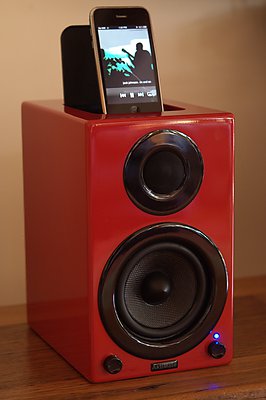
I was curious as to how sound quality fared when using the in-built iGadget dock. I compared the inbuilt dock with a Pure i-20 dock, with the i-20 analog output connected to the Micro’s line input. The Pure i-20 is unusual amongst inexpensive docks in that it takes the digital output from the iGadget and uses its own internal DAC to generate the analog signal, instead of just buffering the analog signal from the iGadget.
I used Configuration A for this comparison, and synced the playlist onto my iPhone 3Gs in Apple Lossless format. While the two docks sounded slightly different, I found it fairly hard to pick significant differences. If pushed, I would say that the external dock sounded a little clearer whereas the internal dock had a slight tendency to muffle vocals; but this was very slight.
I also compared both docks to the internal DAC driven by USB from the computer. I felt that neither was quite as good as the USB DAC… but bear in mind the comment above about the difference the player on the computer makes. Again, the differences are slight and to be quite honest I got rather tired of swapping docks and adjusting levels trying to detect minute differences. I decided that the Micro is best suited for computer use (with some experimentation with the player), but you don’t lose much if plugging in an iGadget, provided that you are using lossless music files.
Other sources
Since the Micro has a line input, any source can be connected to it. For sources with RCA outputs, you will just need a (readily-available) RCA-to-3.5mm cable. I tried a Virtue Audio Piano M1 CD player connected to the line input, and have to say it worked fine. This CD player must have higher output levels than the other external sources that I tried, though, as the volume control was a bit “hair trigger” in this case and the right channel came on before the left, making very quiet listening difficult.
The sound was good, with a slightly more extended top end compared to the internal DAC. At any rate, if you have a need to play CDs from time to time or want to use some other source like a tuner, it’s simply a matter of connecting it and turning the selector switch on the front of the active Micro.
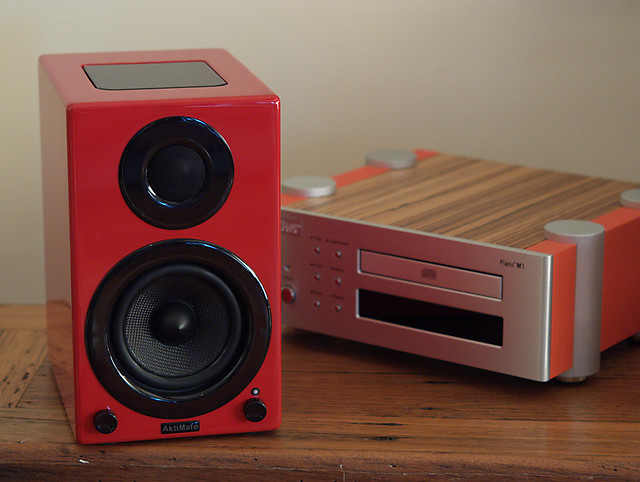
Dressing it up
In Configuration B, with the speakers toed in to intersect in front of me, I found the treble to be a bit “hot.” Since we’re playing files from a computer, I decided to employ some equalization (EQ). This type of thing is not for everybody – some folks may not have EQ, not want to learn how to use it, or subscribe to the “bit perfect” mantra. To each their own.
I used the fabulous Fab-Filter Pro-Q equalization plugin in Pure Music to apply three equalization filters:
- A shelving filter to compensate for the rising response of the tweeter, that gently shelves down the treble by 4-5 dB from 4 kHz to 20 kHz.
- A shelving filter to bring down the mids and treble – this is effectively the same as boosting the bass, but avoids any possibility of driving the digital filter into clipping. I used a shelf of 4 dB centered at 120 Hz.
- A boost of 3 dB at 2200 Hz to fill in the dip there a bit.
The bottom pair of curves in Figure 4 show the response after this equalization. Overall, this is a more well-balanced “in room” curve than the middle set of curves. More could be done, but these three filters accomplish most of the job. In terms of overall frequency balance, the curves are similar to Configuration A, with a bit more weight on the bass.
Audibly, the change from the “straight ahead” to the “toed in” placement is particularly noticeable on the acoustically-recorded (classical) tracks, where the overall soundstage and sense of space is more natural. Also, you can move your head further to one side until the soundstage collapses into the nearest speaker. Bass was not as obviously more present as the curves suggest, but rather the overall tonal balance was more neutral.
A drawback of using this type of shelving equalization with a 16-bit converter is a slight loss of resolution, so I spent most of my Configuration B listening time with an external (24-bit 96 kHz) DAC added – the little Fostex HP-A3. In direct comparison with the Fostex, the weaknesses of the internal DAC become apparent: the Fostex rendered vocals with more delicacy and clarity, while the internal DAC would occasionally sound slightly strained; on busy tracks like Caro Emerald’s Absolutely Me, the Fostex kept instruments separated where the internal DAC tended to get a bit confused. On classical tracks like the Ravel, the Fostex presented the background reverberation on plucked strings a tiny bit better.
While using an external DAC combined with in-computer EQ did take resolution and soundstaging up a notch, it’s hard to see that it’s worth the significant increase in complexity and cost – the extra software and hardware used here triples the total cost of the system. And, this all starts to feel that it runs counter to the spirit of a system like the Micro – we might as well go to separates. As an experiment, I tried putting together a “separates” desktop system to compete with the Micro using components I had on hand: the Fostex DAC, a Virtue Audio ONE.2 integrated amp (with standard power supply), and a pair of DIY monitors using the Jordan JX92s driver. This setup – with or without EQ – failed to better the Micro in any significant way.
Regardless of what anyone thinks of the above experiments, the point here is simple: it is harder than you might think to do better than the Micro for any reasonable cost ratio.
Concluding remarks
I’ve really enjoyed my time with the Micro. If only the treble were a little less hot, I would be completely over the moon about them. As they are, I have to be more reserved, because if simply plonked into (say) a living room, the Micros will tend to sound bright. With the specific desktop placement described above (configuration A), this is largely alleviated by positioning the listener off-axis, albeit at the cost of a little reticence in the midrange.
Placed carefully, the Micro will surprise with its ability to create a realistic image and an enjoyable listening experience with well-recorded and relatively sparse recordings. Remember that this is not just a component, but practically a complete system that you can buy for under four hundred dollars. While at times its limitations make themselves known, make no mistake: the Micro rewards you if you feed it well. The superb finish on the Micro doesn’t hurt its case either, making it acceptable in situations in which a plasticky “studio monitor” type of speaker will simply not be suitable.
Overall, the Aktimate Micro presents a compelling, inexpensive package that is undoubtedly “greater than the sum of its parts.” Considering that this is a speaker system that includes not only an amplifier but also the USB DAC for connection directly to a computer, it’s also a remarkable bargain. I did note that the price of the Micro does vary around the world (see list below). I’m now quite intrigued by this class of component, and it will be interesting to see if this type of product takes off – I certainly hope it does. Until next time, happy (desktop) listening!
Specifications
- Power Output: 40 W @ 1 kHz into its own 4 ohm load
- Woofer : 100mm / 4” Kevlar design
- Tweeter: 25mm soft dome – neodymium magnet – magnetically shielded
- Frequency Response : 70Hz – 25 kHz Amplifier:20Hz – 25 kHz
- Power Amplifier Type: Class D
- DAC (Only on USB input) : TI PCM2704 16-bit 48 kHz
- Inputs: iPod dock, 3.5mm jack line in, USB audio
- Input Impedance : 10 kohm
- Passive speaker impedance: 4 ohms
- Protection: Temperature; Short circuit on output; Low & high voltage supply
- Mains voltage : Universal 100 – 240 V 50-60 Hz
- Inclusions: Power cable, Speaker cable, 3.5mm jack cable, USB cable, Banana plugs (2 red/2 black), Rubber feet
- Dimensions W x D x H : 145 x 200 x 240 mm; 5.7 x 7.87 x 9.45 ins
- Finish: Black, Red or White high gloss
- Weight: 6.95 kg; 8.2 kg Packed
- Warranty: 12 months – original purchaser only – applicable in country of purchase
- More information: http://www.aktimate.com.au/micro.html
Manufacturer/distributor and pricing
- Epoz
- $385 (Australia)
- £260 (United Kingdom)
- $499 (United States)
Acknowledgements
This review was greatly improved by comments from Patrick Dillon and Dan Bair.
HifiZine thanks Epoz, creator of the Aktimate brand, for the loan of the Micro for the duration of the review period.




Hi John,
Enjoyed the review of the aktimates, thorough indeed. I have a pair of these and they do the job at hand very well. Especially for that price tag!
Im curious though… perhaps you could explain the need for internal DAC in the aktimate when ipod/phone is docked?
Iphone/ipod have thier own DAC no?
what purpose does it serve?
Hi James, thank you for the kind words, much appreciated. The internal DAC is used when connected from a computer via USB. When an iPod/iPhone is plugged in, the Micro plays the line out from the iPod/iPhone, as far as I am aware. In that case, the internal DAC is not being used.
Hey John,
Thanks for this review – I’ve got a pair of red aktimate minis and are used in the lounge for watching movies and listening to music… They sound & look very nice.
I’m tempted to pickup a pair of the minis for the PC… in red of course.
Hi Chris, thanks for the comment. Aktimate have just come out with a “Mini+”. It’s on their website now although I haven’t seen one in person.
Thanks for this very detailed review, which I just found. I am thinking about a set of the Micros for my desktop. What would you say to the idea of connecting them to a powered subwoofer — the Audioengine S8, for instance, comes in gloss white and can be wired to receive the source and then transmit out to the Micros, as far as I can tell. The disadvantage is that you have to bypass the DAC built-in to the Micros on the USB connection. Anyway, I would be curious to hear your thoughts. Maybe this is overkill for computer listening!
Hi Henry, that does change the value equation as not only are you bypassing the internal DAC but you are also high-passing the speaker somewhere above its 60 Hz rolloff. In a desktop situation that would suggest to me a smaller sealed speaker would be more optimal (I don’t have any specific recommendation, just looking at it from a system point of view).
Can you explain this again more slowly? ; )
Sorry, my mistake, I had assumed that the output from the S8 had a highpass filter i.e. removed the lows from the signal sent to the main speakers. But it’s not, it passes through the full-range signal. I think it would probably work fine, based on the measurements I would try setting the filter on the S8 at 50-60 Hz, and also at around 120 Hz, as a couple of starting points to try.
Got it – thank you. Great review and site; just found it and have now read several posts. Very instructive.
Hi John.
Thanks for putting so much time into this review, which in turn played a big part in my recent decision to buy a set of AktiMate Micro speakers for myself. I’m delighted with them so far! One question I thought you might be able to help with: did you have any experience with the rear of the active speaker reaching significantly high temperatures (so much so that it’s uncomfortable to touch) after any period of time?
Hi James, you’re welcome, it was a new challenge for me and I’m glad that it helped you. I don’t recall the active speaker getting very hot. I would expect some increase in temperature would be normal after running the speakers at volume for a while, and solid state components do have a fairly high temperature rating… quite a lot higher than we do! But if this is happening even when the speakers are not being played loudly, perhaps the best thing to do would be to contact Aktimate to enquire.
Cheers, John. I suspect a large part of this has to do with my being slightly pedantic, however, I’ll be sure to keep an eye on it. Thanks again for your response!
What a a comprehensive review! Thank you very much.
I recently bought a pair of these gorgeous speakers with the intent of using my itunes library on my MacBook which is also a recent purchase.
The sound from my iPod and 3.5mmm jacks is great. But…the USB input does not work. This is the latest USB 3.0 version and I have been advised by the dealer that the Micro’s only work with USB 2.0!!
Any comments would be appreciated
Hi Krys, thanks for your comment and I’m sorry to hear that you are having issues. When you run the MIDI Audio Setup application, does the Aktimate show up in the list? What about in the System Preferences Audio screen?
Hi John, thanks for putting me on the right track. It was simply a set up problem and they sound even better from the USB port. Couldn’t quite believe the dealer’s story. Thanks again.
Glad you got it sorted 🙂
Has anyone used the banana plugs on Aktimate speakers? I can’t figure them out at all, and any video tutorials and such I found on the net are for different kinds of banana plugs. These plugs just don’t seem to fit in anywhere, either I’m really stupid or they are the wrong kind. Cheers